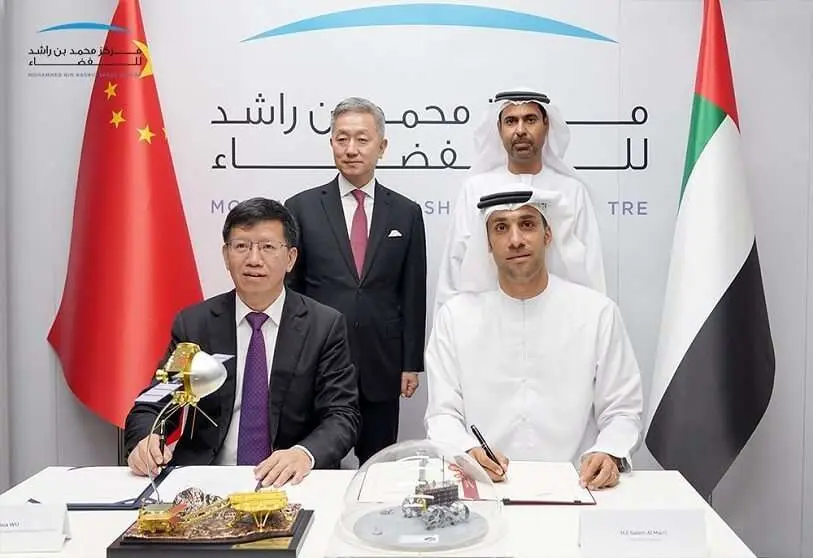Emirates and China join forces to reach the surface of the Moon hand in hand

The Union of Arab Emirates has surprised the vast majority of the international space community by signing a cooperation agreement with Beijing to host its Rashid 2 vehicle on China's Chang'e-7 mission, which is scheduled to fly to the Moon and land on its surface in 2026.
The first bilateral space agreement between China and the UAE was signed on 16 September by the deputy head of the China National Space Administration (CNSA), Wu Yanhua, and the director general of the Mohammed bin Rashid Space Centre (MBRSC) in Dubai, Salem al-Marri, who said that Rashid 2 is a mission dedicated to "exploring new areas of lunar geography".
China opened its Chang'e-7 mission to international cooperation in June 2021, which the Emirati authorities took advantage of to negotiate a pact with Beijing, to take part in an exploratory mission by President Xi Jinping and to diversify its stakes and its expectations of becoming a player to be reckoned with on the world space stage

A 8 tonnes spaceship , the ambitious Chang'e-7 mission consists of a lunar orbiter, a surface module, an autonomous rover and a small robotic probe to explore craters in search of water. The agreement now reached between CNSA and MBRSC means that it will also carry a small rover developed by Emirati engineers.
The Gulf nation's decision has not come as a surprise to the Biden Administration and NASA, which have been informed in advance. A key geopolitical, military and economic ally of the United States in the Middle East region, the UAE was one of the first countries to sign NASA's Artemis agreements on 13 October 2020.

By being present at Artemis, the Vice President, Prime Minister of the UAE and Ruler of Dubai, Sheikh Mohammed bin Rashid al-Maktoum, is ensuring his participation in the various robotic and manned missions led by Washington for the return of humans to the moon after 2025 and the future exploitation of its resources.
The UAE Space Agency and the MBRSC have other close and important cooperation agreements with the US space agency. One of these is for the training of Emirati astronauts at NASA's Johnson Space Center in Houston, Texas, where the four members of its Astronaut Corps, three men and one woman, have so far been trained.
Both institutions also maintain links with US space companies. One of the most important is with Axiom, with which the MBRSC signed a contract last April for the second Emirati astronaut, Sultan al-Neyadi, to fly on the Crew Dragon 6 mission to the International Space Station (ISS) in the spring of 2023, along with two American and one Russian astronaut.

But, like NASA, the Chinese space agency offers more than enough guarantees for the investments that Emirates is willing to make in the space technology of the great Far Eastern country. Beijing has already successfully placed two surface modules and two rovers on the Moon, both on the visible and the dark side.
The 1.2-tonne Chang'e-3 and its rover Yutu landed on the Moon in December 2013. At 3.6 tonnes, Chang'e-4 and Yutu-2 landed in January 2019 on the side not visible from our planet. And the 8.2-tonne Chang'e-5 mission landed on 1 December 2020 and sent small samples of the Moon back to Earth 15 days later - quite a feat.

Chang'e-6 will fly in 2024 to improve on the previous mission, the same year that Israel and the United Arab Emirates want to place the joint Beresheet 2 mission on the Moon, whose agreement was ratified in October 2021.
No details have been released on the Rashid 2 lunar rover, except that it will be a development of the smaller, 10-kilogram Rashid 1, which incorporates two highly sensitive cameras. If there are no delays caused by the consequences of the war in Ukraine on the space sector, it is scheduled to take off from Cape Canaveral (Florida) next November on a SpaceX Falcon 9 rocket.

MBRSC has a contract with the private Japanese company Ispace for the maiden mission of its Hakuto-R lunar surface module to deposit Rashid 1 on Earth's natural satellite.
Final vibration and thermal vacuum testing of Hakuto-R is nearing completion at the company's IABG headquarters in Germany, which must certify that the entire system is ready to withstand liftoff and its stay on the dusty Moon. Once testing is completed in late September or early October, Hakuto-R will be shipped to the United States to be prepared for launch.

The Moon is the UAE's second outer space target after Mars. The Al-Amal (Hope) spacecraft was launched from Japan on a Japanese H-2 rocket in July 2020. The first satellite owned by an Arab nation to reach and orbit the Red Planet has been circling and investigating its atmosphere since early 2021, making the Gulf nation the fifth nation to reach our neighbouring planet.











